Winter transforms not just the landscape around us but also how we approach our beauty routines, and nothing captures the essence of cold-weather elegance quite like a perfectly styled braid.
When temperatures drop and cozy sweaters become your daily uniform, your hairstyle deserves the same seasonal update—one that keeps your hair protected from harsh winds, dry indoor heating, and static electricity while looking absolutely stunning.
Whether you’re heading to a holiday party, enjoying a snowy weekend getaway, or simply navigating your daily routine, braids offer the perfect combination of practicality and style that winter demands.
33 Easy Winter Hair Braids You’ll Love brings you an expertly curated collection of braid styles ranging from simple three-strand classics to intricate crown designs, each chosen specifically for their winter-friendly qualities and achievability at home.
This comprehensive guide walks you through trendy options like chunky knit-inspired braids, sleek office-appropriate styles, romantic date-night looks, and protective braiding techniques that maintain hair health throughout the season.
You’ll discover detailed styling instructions, helpful tips for working with winter hair texture, product recommendations for cold-weather styling, and creative ways to accessorize your braids with seasonal touches.
From beginners attempting their first fishtail to experienced braiders seeking fresh inspiration, this article delivers practical solutions that work with various hair types, lengths, and personal styles, ensuring you’ll find multiple favorites to rotate through the entire winter season.
Contents
- 1 1. Classic Three-Strand Winter Braid
- 2 2. Chunky Fishtail Braid
- 3 3. Dutch Braid Crown
- 4 4. Messy Side Braid
- 5 5. Waterfall Braid
- 6 6. Boxer Braids (Double Dutch Braids)
- 7 7. Rope Braid Ponytail
- 8 8. French Braid Into Low Bun
- 9 9. Pull-Through Braid
- 10 10. Braided Top Knot
- 11 11. Four-Strand Braid
- 12 12. Halo Braid with Loose Curls
- 13 13. Twisted Side Braid
- 14 14. Bubble Braid Ponytail
- 15 15. Infinity Braid
- 16 16. Milkmaid Braid
- 17 17. Zipper Braid
- 18 18. Snake Braid
- 19 19. Braided Headband Style
- 20 20. Lace Braid
- 21 21. Braided Mohawk
- 22 22. Braided Bun Combination
- 23 23. Side-Swept Dutch Braid
- 24 24. Triple Braided Ponytail
- 25 25. Braided Half-Up Half-Down
- 26 26. Reverse French Braid (Dutch Braid Variant)
- 27 27. Pancaked Braids
- 28 28. Diagonal Lace Braid
- 29 29. Wrapped Braid Bun
- 30 30. Accent Braids with Loose Hair
- 31 31. Knotted Braid
- 32 32. Twisted Crown Braid
- 33 33. Braided Pigtails (Double Side Braids)
- 34 Essential Products for Winter Braiding Success
- 35 Accessorizing Winter Braids
- 36 Conclusion
1. Classic Three-Strand Winter Braid

The classic three-strand braid serves as the foundation for winter hairstyling, offering simplicity that never goes out of fashion while providing essential protection against harsh weather conditions.
- This timeless technique divides hair into three equal sections that weave over and under each other in an alternating pattern, creating a rope-like texture that’s both elegant and functional.
- Winter weather often makes hair more prone to tangling and breakage, making this braid an excellent protective style that keeps strands secured and minimizes friction damage.
- The three-strand braid works beautifully with all hair types and lengths past shoulder-level, requiring no special tools beyond a hair elastic and approximately three minutes of styling time.
- Adding texturizing spray before braiding creates extra grip for fine hair, while applying smoothing serum helps tame frizz on thicker or coarser textures during dry winter months.
- This versatile style transitions effortlessly from casual weekend activities to professional environments, requiring only subtle adjustments in tightness and placement to match different dress codes.
2. Chunky Fishtail Braid
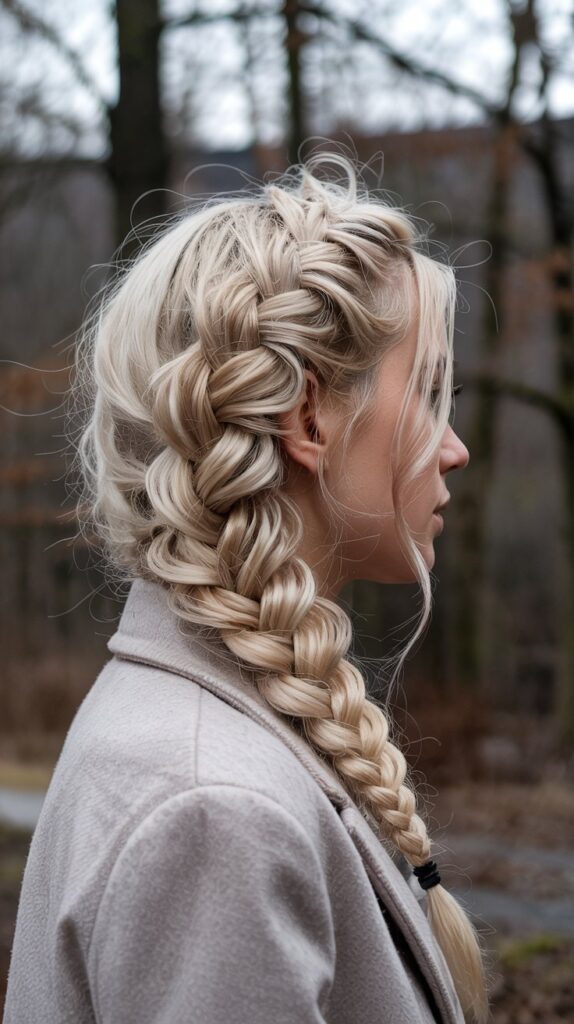
The chunky fishtail braid brings a modern, textured approach to winter styling that mimics the cozy aesthetic of knitted scarves and chunky sweaters defining cold-weather fashion.
- Unlike traditional fishtails that use small sections, the chunky version pulls larger pieces from each side, creating bold, statement-making segments that showcase dimension and movement.
- This technique involves taking a thick outer section from one side, crossing it over to join the opposite side, then repeating with alternating sides down the length of your hair.
- The relaxed, slightly messy finish of chunky fishtails perfectly complements winter’s casual-luxe aesthetic while hiding the static and flyaways common in cold, dry air.
- Pancaking the braid by gently pulling apart the woven sections creates even more volume and width, transforming thin or medium hair into a dramatically full winter statement piece.
- This style holds particularly well on second or third-day hair when natural oils provide texture and grip, making it ideal for busy winter mornings when hair washing isn’t on the schedule.
3. Dutch Braid Crown
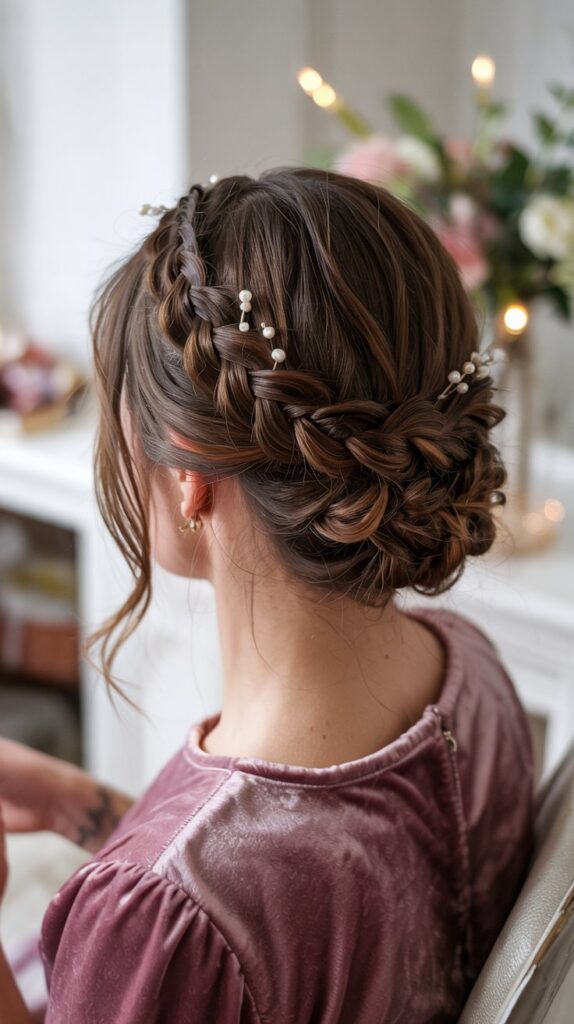
The Dutch braid crown circles the head like a woven halo, offering both regal beauty and practical warmth by keeping hair close to the scalp during frigid winter days.
- This inside-out braiding technique crosses sections under rather than over, creating a raised braid that sits prominently atop the hair like a dimensional crown.
- Starting at one ear and working around the head’s perimeter, the crown braid incorporates new sections from the hairline while progressing toward the opposite ear where it’s secured and tucked.
- Winter accessories like knit beanies and earmuffs slip on easily over crown braids without disturbing the style, unlike down braids that create uncomfortable bulk.
- The secure nature of this style makes it excellent for winter sports activities including skiing, ice skating, and snowboarding where hair needs to stay completely controlled.
- Adding small seasonal embellishments like tiny gold stars, pearl pins, or evergreen sprigs transforms this everyday braid into holiday-party-ready elegance within seconds.
4. Messy Side Braid
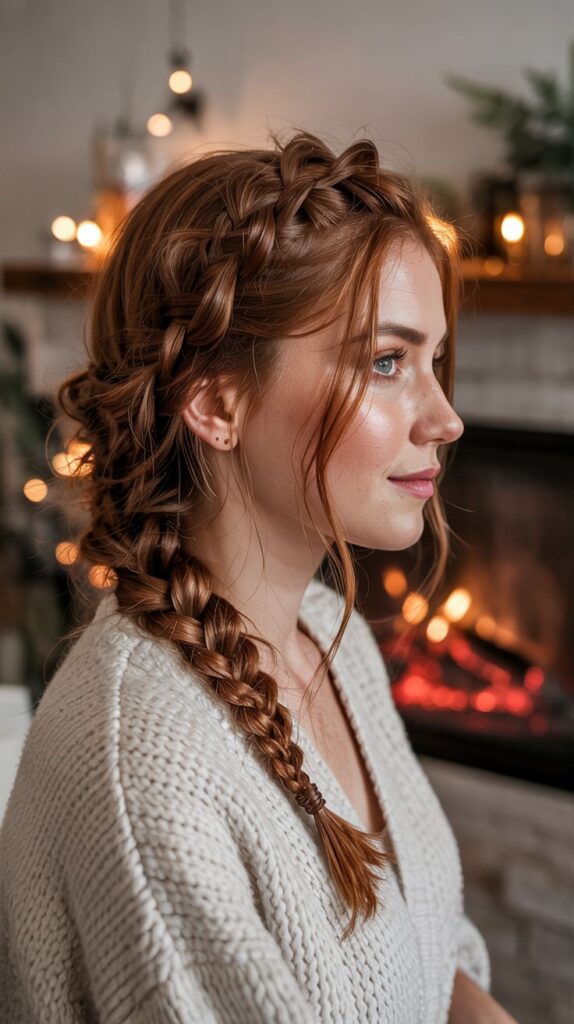
The messy side braid embraces winter’s relaxed, hygge-inspired aesthetic while providing effortless style that looks intentionally undone yet beautifully composed.
- This approach deliberately loosens traditional braiding tension and pulls out strategic face-framing pieces to create soft, romantic volume rather than sleek perfection.
- Sweeping all hair to one side before braiding adds asymmetrical interest that complements winter’s layered clothing and draped scarves without looking overly styled.
- The intentional imperfection of messy braids actually helps disguise winter hair challenges including dryness, static, and the slightly rough texture caused by indoor heating.
- Using dry shampoo at the roots before braiding adds grip and texture while giving fine hair the necessary volume to achieve that coveted full, lived-in appearance.
- This style pairs exceptionally well with winter’s off-shoulder sweaters, turtlenecks, and statement coats, providing visual balance to heavy winter fabrics.
5. Waterfall Braid

The waterfall braid creates the illusion of hair cascading through the woven pattern like a flowing stream, bringing movement and dimension to winter styling.
- This decorative technique weaves a horizontal braid across the head while dropping sections at regular intervals, allowing them to fall freely and blend with the remaining loose hair.
- Each dropped section creates a vertical “waterfall” strand that catches light beautifully, adding depth and interest to winter hair that might otherwise appear flat under hats.
- The waterfall braid works particularly well for special winter occasions including holiday parties, winter weddings, and seasonal photoshoots where elegant half-up styles are desired.
- Curling the loose waterfall sections with a large-barrel iron enhances the flowing effect and creates romantic waves that complement the braided portion’s structured beauty.
- This style requires moderate skill but delivers impressive visual impact that makes viewers assume significantly more time and effort than the actual 10-15 minute styling process requires.
6. Boxer Braids (Double Dutch Braids)

Boxer braids deliver athletic-chic functionality perfect for active winter lifestyles while maintaining sleek, camera-ready polish that transitions from gym to street style.
- Two parallel Dutch braids run from the hairline to the nape, sitting raised atop the head and creating clean, symmetrical lines that keep every strand secured.
- Originally popularized in athletic contexts, these braids prevent hair interference during winter sports while providing a fashion-forward look embraced by street style and runway trends.
- The tight, close-to-scalp braiding technique offers maximum protection from winter wind, snow, and moisture that can cause frizz and damage in looser styles.
- Boxer braids work excellently under winter hats, helmets, and hoods without creating uncomfortable pressure points or disturbing the braided pattern when accessories are removed.
- This style typically lasts 2-3 days when properly secured, making it ideal for winter travel, ski trips, or busy weeks when daily styling isn’t feasible.
7. Rope Braid Ponytail
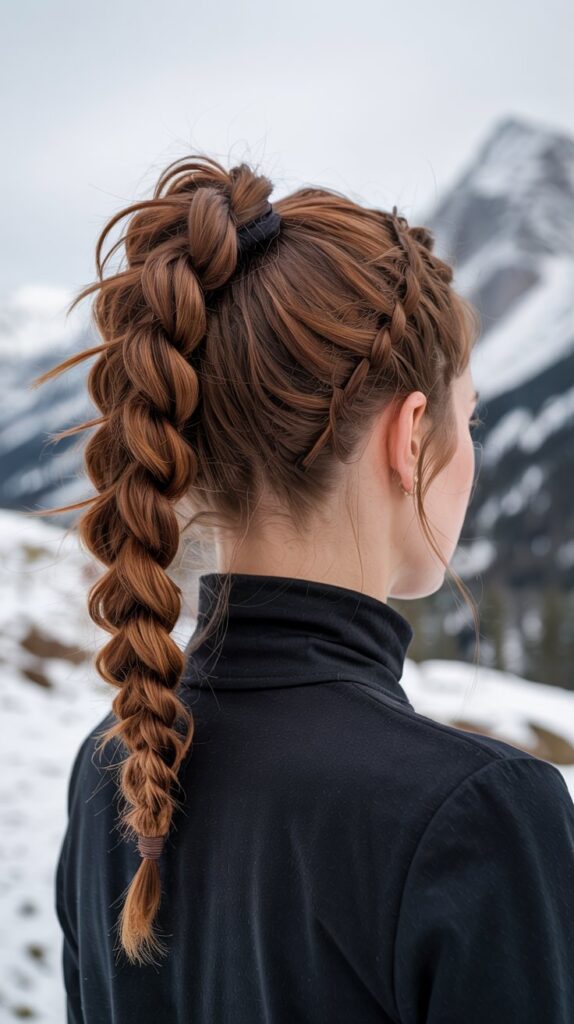
The rope braid ponytail combines the polish of gathered hair with the textured interest of twisted braiding, creating a refined yet easy winter style.
- This technique divides a ponytail into two sections that twist individually in one direction before wrapping around each other in the opposite direction, creating self-securing spiral tension.
- Rope braids form faster than traditional braiding methods while delivering similar hair-securing benefits, making them perfect for rushed winter mornings.
- The uniform, cylindrical shape of rope braids creates visual length that flatters all face shapes while keeping hair protected from winter’s drying effects.
- Adding texture spray throughout the ponytail before twisting prevents slippage and helps fine or silky hair maintain the rope structure throughout the day.
- This style works particularly well for professional winter environments where polished appearance matters but overly elaborate styling would seem impractical or inappropriate.
8. French Braid Into Low Bun

Combining a French braid with a low bun creates sophisticated elegance perfect for winter’s formal events while keeping the neck warm and hair completely secured.
- Starting with a traditional French braid from the crown, this style incorporates all hair into the braid before coiling the remaining length into a classic bun at the nape.
- The braided top section adds textural interest that prevents the overall look from appearing too severe or plain, balancing sophistication with visual dimension.
- Low buns sit comfortably beneath coat collars and scarves without creating bulky protrusions that can make winter outerwear fit awkwardly around the head and neck.
- This hybrid style keeps hair completely off the face and secured against winter wind while maintaining enough polish for professional settings, holiday dinners, and winter weddings.
- Using bobby pins that match your hair color and a strong-hold hairspray ensures the style stays intact through winter weather and temperature transitions between outdoors and heated interiors.
9. Pull-Through Braid
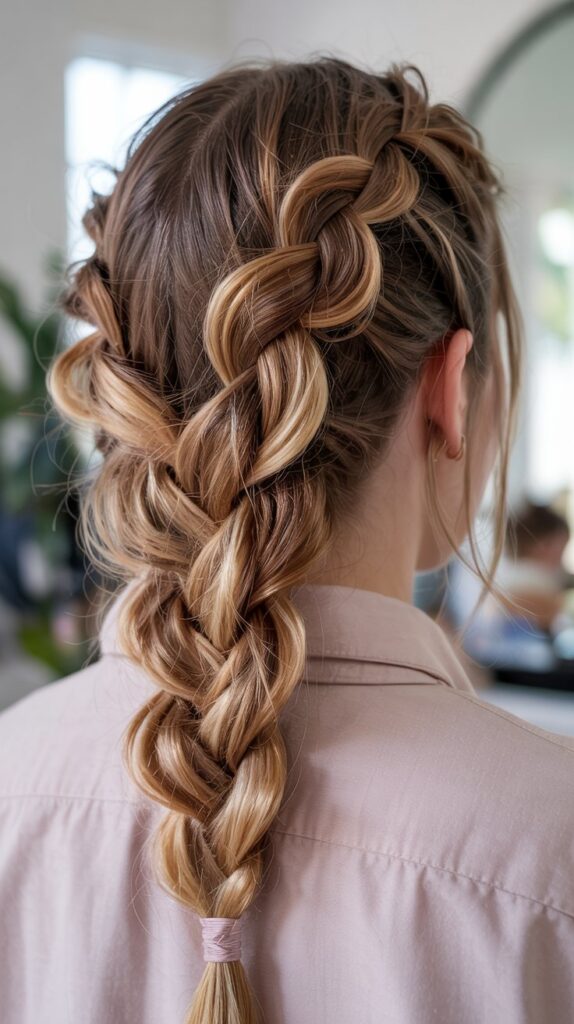
The pull-through braid creates the appearance of an intricate, voluminous braid without requiring traditional braiding skills, making it accessible for winter styling novices.
- This technique uses a series of small ponytails that pull through each other, creating stacked sections that mimic complex braiding while using only hair elastics.
- Each ponytail gets split in half, with the next section pulling through the middle before securing with another elastic, continuing this pattern down the length.
- The resulting style offers exceptional volume and width, making it ideal for fine or thin hair that appears fuller when styled with this dimensional technique.
- Winter’s dry indoor air actually benefits this style since slightly rougher hair texture helps the pulled sections maintain their shape rather than slipping back into place.
- Clear or matching elastics every few inches provide structure while remaining invisible, and gently pancaking each section creates the dramatic, oversized look characteristic of pull-through braids.
10. Braided Top Knot
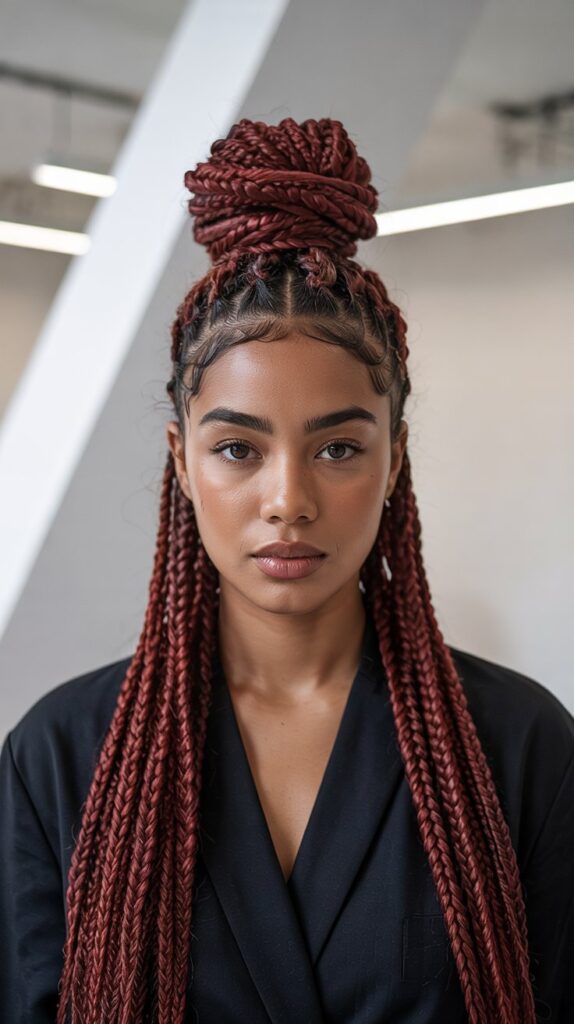
The braided top knot positions a braid-wrapped bun at the crown, combining the elegance of updo styling with the casual accessibility of everyday buns.
- Braiding the ponytail before wrapping it into a topknot adds texture and grip that helps the bun maintain its shape, particularly important for slippery fine hair common in winter static conditions.
- The elevated positioning keeps hair completely off the neck and face while creating vertical lines that elongate the silhouette—flattering for those wearing bulky winter sweaters.
- This style transitions seamlessly from casual winter weekends to evening events simply by adjusting tightness, adding accessories, or pulling out a few face-framing pieces.
- Winter hats slip on and off easily over braided top knots without destroying the style, making this an excellent choice for commuters and outdoor workers.
- Using a sock bun or donut insert underneath the braided wrap creates fuller-looking results for those with thin or medium-density hair seeking more dramatic impact.
11. Four-Strand Braid
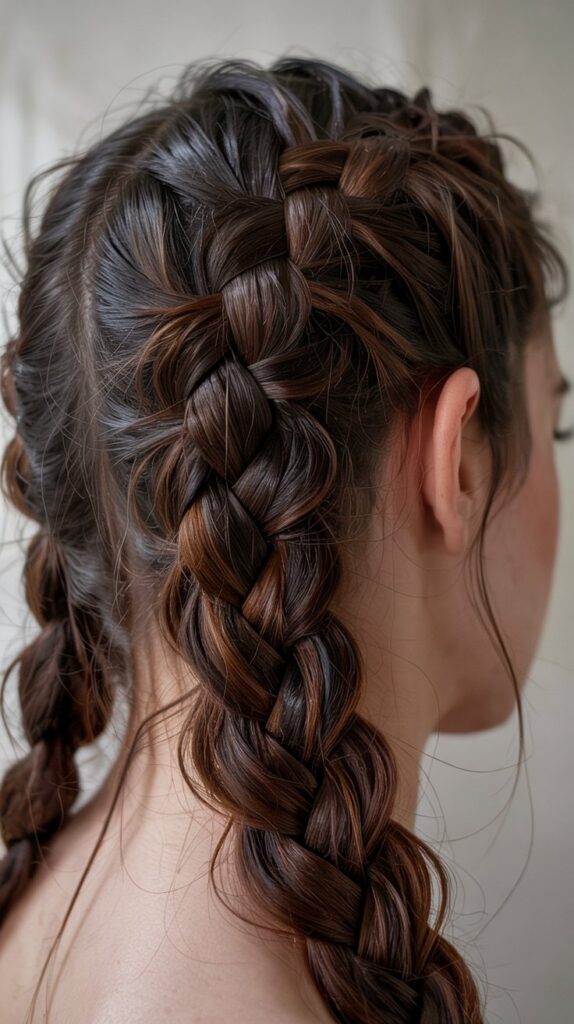
The four-strand braid introduces complexity that creates unique woven patterns distinguishing your winter style from standard three-strand braids.
- This advanced technique divides hair into four sections with specific over-under crossing patterns that create a wider, flatter braid with more visual complexity than traditional methods.
- The alternating weave pattern catches light differently than three-strand braids, creating dimensional interest that prevents winter hair from looking dull or lifeless.
- While requiring practice to master, four-strand braids offer distinctive styling that sets wearers apart during winter holiday gatherings and special occasions.
- The wider structure of four-strand braids works particularly well for thick, heavy hair that can overwhelm simpler braiding techniques or appear too bulky in standard three-strand styles.
- Tutorial videos and practice sessions help build muscle memory for the specific crossing pattern, which becomes automatic after 4-5 complete practice braids.
12. Halo Braid with Loose Curls

Combining a halo braid with flowing curls creates romantic winter elegance perfect for holiday celebrations and cold-weather date nights.
- A thin to medium braid wraps around the crown like a headband while the remaining hair flows freely in soft waves or curls beneath.
- This hybrid style keeps hair off the face where winter wind and scarves might cause tangles while maintaining the flowing, feminine aesthetic of wearing hair down.
- The contrast between structured braiding and loose curls creates visual interest that photographs beautifully for winter celebrations, holiday cards, and seasonal social media content.
- Using a small section of hair for the halo keeps the braided crown delicate and refined rather than heavy or overwhelming, maintaining proper proportion with the loose curls.
- Hidden bobby pins secure the braid’s ends beneath the loose hair, creating the illusion of a continuous crown without visible mechanical fastenings.
13. Twisted Side Braid
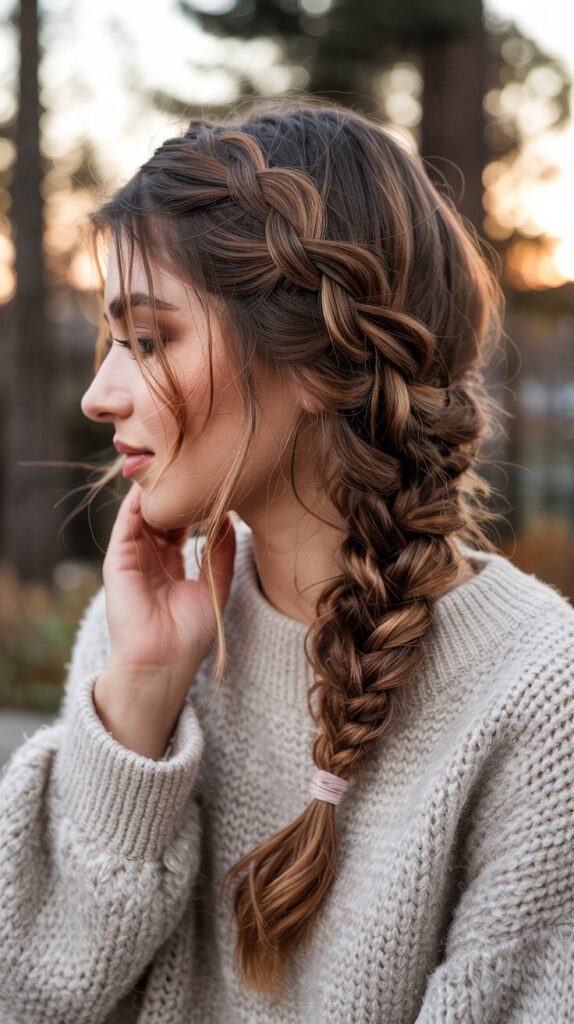
The twisted side braid offers a softer alternative to traditional braiding while maintaining the protective and styling benefits essential for winter hair management.
- Rather than traditional over-under braiding, this technique twists two sections around each other while gradually incorporating additional hair from the sides.
- The resulting style appears more relaxed and organic than structured braids, complementing winter’s cozy, informal aesthetic while remaining polished enough for professional contexts.
- Twisting generally takes less time than braiding while providing similar hair-securing benefits, making this technique ideal for busy winter mornings with limited styling time.
- The softer texture of twisted styles works particularly well with winter’s layered clothing and flowing fabrics, avoiding the harsh lines that might conflict with draped scarves and cardigans.
- Adding dry shampoo or texturizing powder throughout lengths before twisting helps maintain the style’s structure throughout the day, preventing slippage common with freshly washed, slippery hair.
14. Bubble Braid Ponytail

Bubble braids transform a simple ponytail into a playful, dimensional style perfect for winter’s festive spirit without requiring traditional braiding skills.
- Clear elastics placed at regular intervals down a ponytail create segmented “bubbles” that are gently pulled apart for volume, creating a chain of rounded sections.
- This technique works excellently for all skill levels since it requires only the ability to tie ponytails, making sophisticated winter styling accessible to braiding beginners.
- The uniform bubbles create a modern, geometric look that feels current and fashion-forward while maintaining enough structure to withstand winter weather conditions.
- Each bubble can be customized in size by adjusting elastic placement, allowing personalization that suits different hair lengths, densities, and desired final appearances.
- Adding decorative elastics, ribbons, or small clips between bubbles enhances the playful nature while incorporating seasonal colors like deep reds, forest greens, or metallic golds.
15. Infinity Braid

The infinity braid creates a distinctive figure-eight pattern that adds mathematical precision and artistic flair to winter hairstyling.
- This advanced technique creates interlocking loops that form infinity symbols throughout the braid’s length, producing a complex appearance that belies relatively straightforward execution.
- The continuous weaving pattern catches light from multiple angles, preventing winter hair from appearing flat or one-dimensional even in low winter light conditions.
- Infinity braids work best on medium to thick hair with enough density to showcase the pattern’s complexity without sections appearing thin or sparse.
- The distinctive styling makes this an excellent choice for winter special occasions where unique hair artistry will be noticed and appreciated by other guests.
- Online tutorials with slow-motion demonstrations help master the specific hand movements required, with most learners achieving success after 3-4 complete practice attempts.
16. Milkmaid Braid
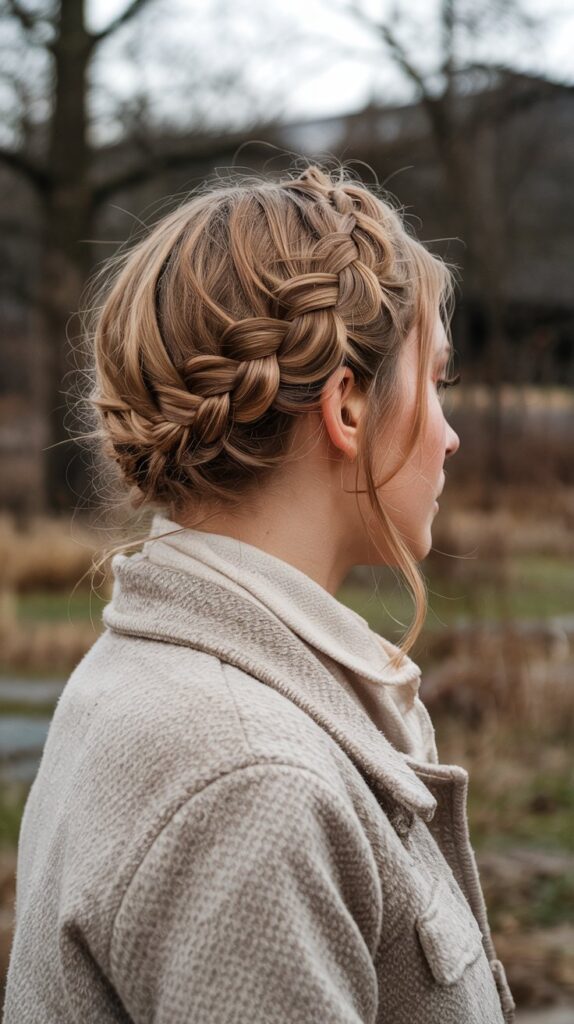
The milkmaid braid channels rustic, pastoral charm perfectly suited to winter’s cottage-core aesthetic while providing complete hair security in harsh weather.
- Two braids starting at the nape cross over the crown and pin in place, creating a braided band across the top of the head reminiscent of traditional European hairstyles.
- This style keeps all hair up and secured while maintaining a softer, more romantic appearance than high buns or tight ponytails that can appear severe in winter’s muted palette.
- Milkmaid braids work beautifully with winter’s layered, textured clothing including cable knits, flannel shirts, and vintage-inspired coats without appearing overly precious or costume-like.
- The crown positioning allows comfortable wearing of over-ear headphones, winter headbands, and earmuffs without disrupting the hairstyle’s structure or creating uncomfortable pressure.
- Adding small fresh or faux flowers, winter berries, or delicate ribbons woven through the braids creates seasonal styling perfect for holiday gatherings and winter celebrations.
17. Zipper Braid

The zipper braid creates an optical illusion of interlocking teeth running down the braid’s center, delivering high-impact style that turns heads at winter events.
- This technique involves creating a standard three-strand braid while pulling small sections from the outer edges through the center, creating the zipper’s teeth appearance.
- The resulting style offers maximum visual impact from a relatively simple modification to basic braiding, making it accessible to intermediate braiders seeking advanced-looking results.
- Zipper braids photograph exceptionally well, making them popular choices for winter holiday photos, special events, and social media content where distinctive styling stands out.
- The technique works best on straight to slightly wavy hair where the crisp lines of the zipper pattern remain visible rather than being obscured by curl pattern.
- Using a small amount of hair gel or pomade on the pulled-through sections helps them maintain their position and creates the sharp definition necessary for the zipper effect.
18. Snake Braid

The snake braid creates a winding, serpentine pattern that appears to slither down the length, offering artistic expression through hairstyling.
- This decorative technique involves creating deliberate curves in the braid’s path rather than allowing it to hang straight, producing an S-shaped or zigzag pattern.
- Strategic bobby pin placement guides the braid into the desired curving pattern while maintaining enough looseness for the style to appear organic rather than forced.
- Snake braids add visual interest to simple winter outfits without requiring elaborate clothing changes, making basic jeans and sweaters appear more intentionally styled.
- The technique works on all braid types including three-strand, Dutch, and French variations, allowing customization based on skill level and desired complexity.
- Incorporating the snake braid into updos or half-up styles creates additional dimension and artistry for winter formal events and holiday celebrations.
19. Braided Headband Style
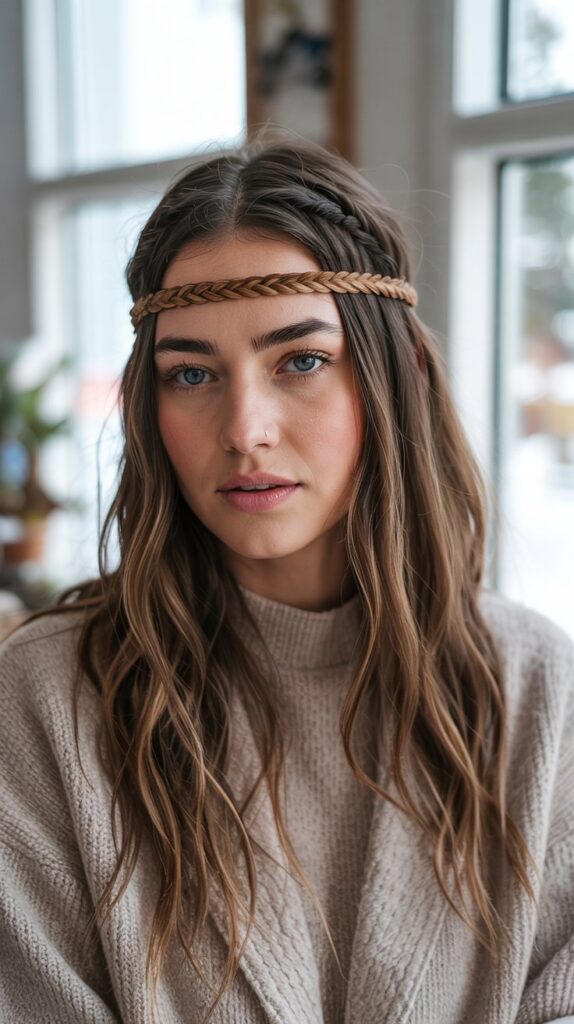
The braided headband uses the hair itself to create a natural accessory that holds back the front sections while allowing the rest to flow freely.
- Taking a thin section from behind one ear, braiding it, and securing it across the crown to the opposite ear creates a hairband from the person’s own hair.
- This style provides the face-framing benefits of wearing a headband without adding external accessories that can slip, cause headaches, or clash with winter outfits.
- The braided band keeps shorter front layers and bangs out of the face while remaining subtle enough for professional environments where dramatic styling might be inappropriate.
- Winter static often causes flyaways around the hairline, and the braided headband naturally controls these problematic pieces while looking intentional and styled.
- Wrapping small sections of loose hair around the braid’s securing points hides elastics and creates a seamless, polished finish that appears more complex than its simple construction.
20. Lace Braid
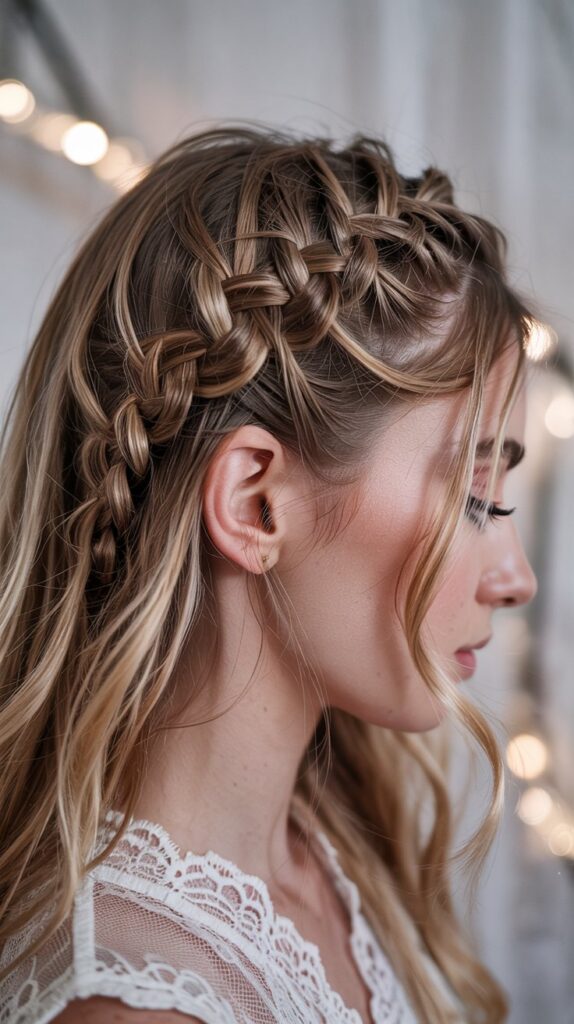
The lace braid creates delicate, intricate patterns by adding sections only from one side, producing an elegant edge similar to fabric lace trim.
- Unlike French braids that incorporate hair from both sides, lace braids add sections from only one side while the other remains smooth, creating an asymmetrical lace-like appearance.
- This technique works beautifully along the hairline or as an accent braid within larger styles, adding decorative detail without overwhelming the overall look.
- Lace braids require more precision than standard French braids but deliver significantly more visual sophistication, making them worth the extra attention for special winter occasions.
- The delicate nature suits winter’s elegant occasions including holiday parties, winter weddings, and formal celebrations where refined styling complements dressy attire.
- Combining multiple lace braids in the same style creates intricate patterns that appear professionally done while remaining achievable for home styling with practice and patience.
21. Braided Mohawk
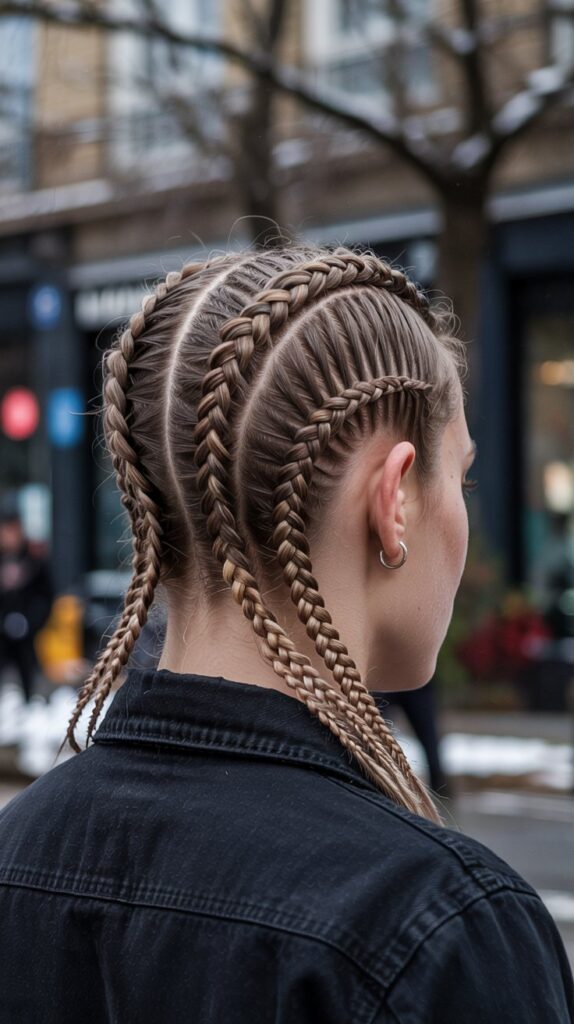
The braided mohawk creates edgy sophistication by combining multiple braids into a centered ridge, perfect for those wanting bold winter style.
- Two or three Dutch braids on each side of the head angle upward and inward, meeting at the center to create a raised braided crest running from forehead to nape.
- This style delivers maximum impact for winter events where standing out matters, including concerts, parties, and creative industry gatherings that appreciate bold styling choices.
- The secure nature makes braided mohawks excellent for active winter pursuits including snowboarding and winter festivals where hair needs to stay completely controlled despite movement.
- Undercut or shorter sides enhance the mohawk effect, but the style also works with longer hair by securing side sections tightly to create the appearance of a ridge.
- Adding metallic thread, thin ribbons, or decorative wire through the braids enhances the edgy aesthetic while incorporating seasonal colors and festive elements.
22. Braided Bun Combination
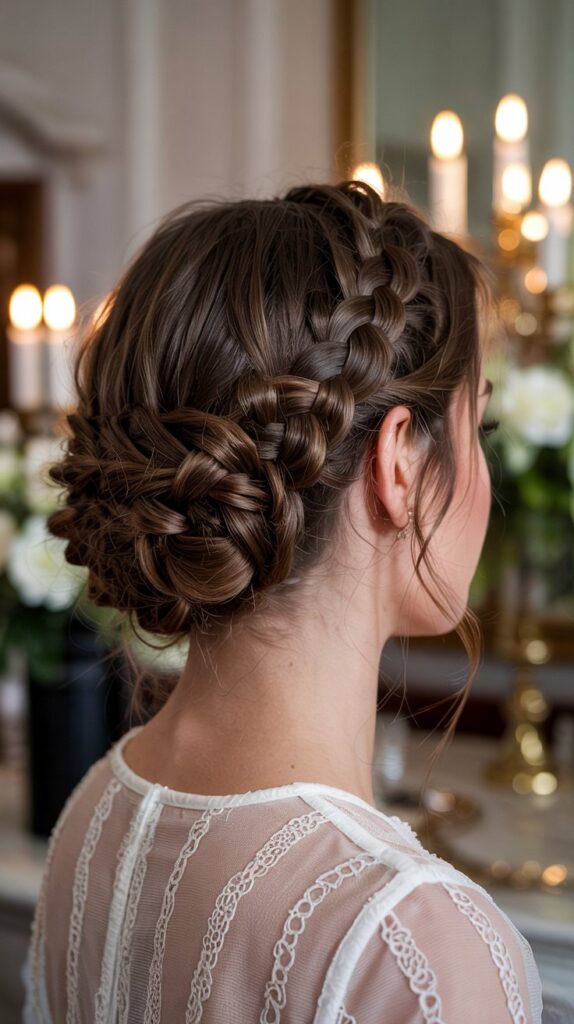
Combining multiple braiding techniques into a single bun creates textured complexity perfect for winter’s formal occasions and special celebrations.
- Incorporating two or more different braid styles—such as Dutch, rope, and three-strand—into one bun adds dimensional interest that photographs beautifully at winter weddings and holiday events.
- The varied textures within the bun create visual richness that prevents updos from appearing too simple or severe, adding artistry to formal winter styling.
- This approach works excellently for professional hairstylists and advanced home stylists wanting to showcase technical skill through creative braid combinations.
- Strategic placement of different braid types throughout the bun’s structure ensures even distribution of textural variety rather than clustering all complexity in one area.
- Securing each braid component before assembling the final bun ensures structural stability that lasts through long winter evenings and extended holiday celebrations.
23. Side-Swept Dutch Braid

The side-swept Dutch braid angles across the head from one side to the other, creating diagonal lines that add dynamic movement to winter styling.
- Beginning near the temple and progressing diagonally across and down toward the opposite shoulder creates dramatic asymmetry that flatters most face shapes.
- The Dutch technique’s raised appearance ensures the diagonal braid remains prominently visible even under winter scarves and high collars that might obscure flatter braiding styles.
- Side-swept braids naturally direct hair to one side of the body, creating balance with winter’s one-shoulder tops and asymmetrical necklines popular in cold-weather fashion.
- This style works particularly well for medium to long hair lengths where the diagonal sweep showcases the hair’s length while maintaining control over wayward strands.
- Leaving the braid slightly looser than standard tight Dutch braids creates romantic softness appropriate for winter date nights and holiday gatherings.
24. Triple Braided Ponytail
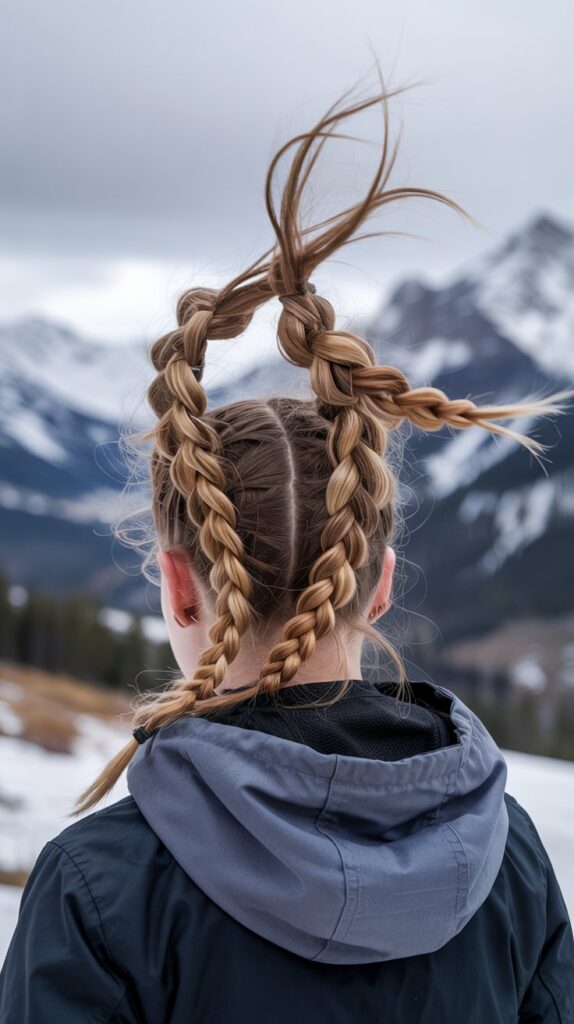
Three braids flowing within a single ponytail create substantial visual interest and volume perfect for winter’s high-impact styling moments.
- Dividing a ponytail into three sections and braiding each separately before allowing them to hang together creates a fuller, more textured ponytail appearance.
- This technique works excellently for medium-density hair that appears thin in single braids, with three smaller braids creating the illusion of greater fullness.
- The separated braids move independently when walking or turning, creating dynamic movement that adds life to winter styling where static and flatness often dominate.
- Each braid can use different techniques—mixing three-strand, rope, and fishtail braids within one ponytail—for maximum textural variety and creative expression.
- Wrapping a small section of hair around the ponytail elastic hides the mechanical element and creates a polished transition between secured base and flowing braids.
25. Braided Half-Up Half-Down
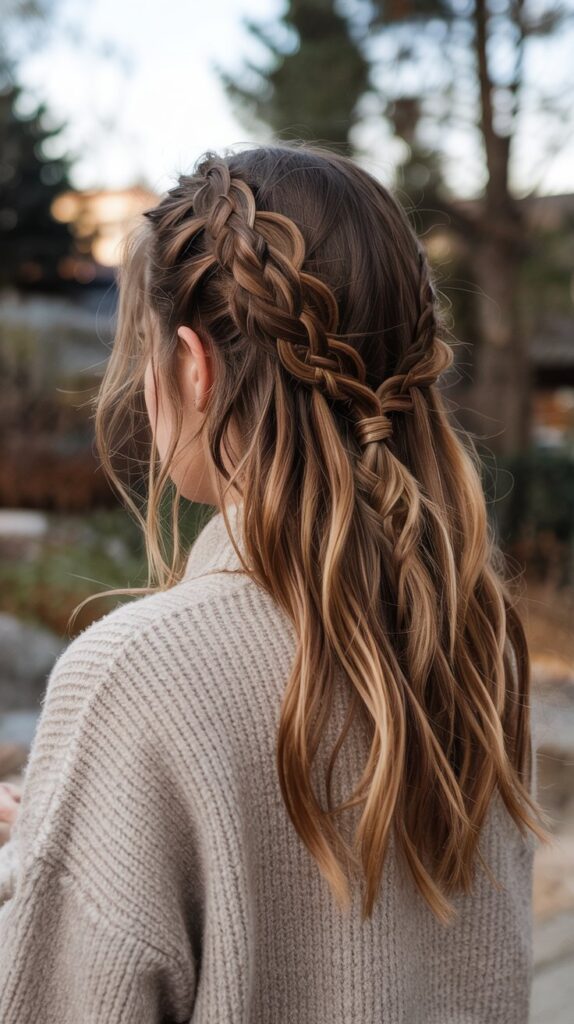
Combining braided top sections with flowing lower lengths offers versatility perfect for winter’s varied social settings and temperature fluctuations.
- French or Dutch braids on each side converge at the crown and secure, allowing the remaining hair to flow freely while keeping the face and top sections controlled.
- This hybrid approach provides the face-framing benefits of updos while maintaining the feminine, romantic aesthetic of wearing hair down during winter celebrations.
- The partial securing prevents top layers from becoming tangled in scarves and coat collars while allowing bottom sections to showcase winter hair care and color treatments.
- Half-up braided styles transition seamlessly from daytime professional settings to evening social events simply by adjusting the loose sections with curling or straightening tools.
- Adding small decorative clips, pins, or seasonal accessories at the convergence point creates focal interest without requiring elaborate styling throughout the entire hairstyle.
26. Reverse French Braid (Dutch Braid Variant)

The reverse French braid technique creates dimensionally raised braids that stand out prominently, making them ideal for thick winter hair requiring secure management.
- Crossing sections under rather than over during the braiding process creates a braid that sits on top of the hair rather than sinking into it, producing three-dimensional texture.
- The raised nature makes reverse French braids more resistant to flattening from winter hats and hoods compared to traditional French braids that can compress easily.
- This technique provides maximum control for thick, heavy hair that might overwhelm flatter braiding methods or feel too bulky in standard styles.
- Winter sports enthusiasts appreciate reverse French braids for their exceptional staying power during active pursuits including skiing, snowboarding, and ice skating.
- The prominent appearance photographs distinctively in winter holiday photos and special events where unique hairstyling adds personality to formal attire.
27. Pancaked Braids
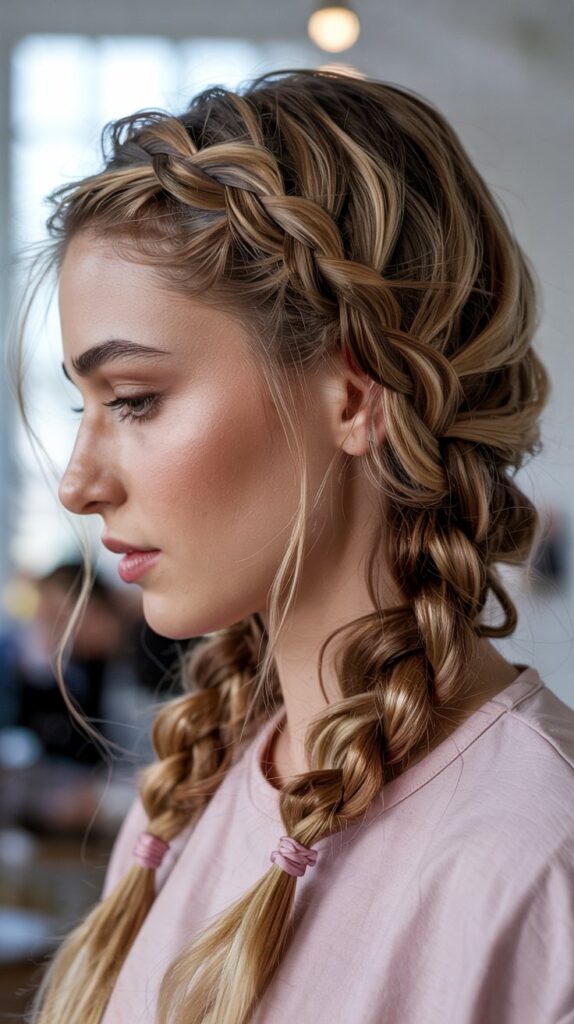
Pancaking—the technique of gently pulling braid sections apart—transforms any basic braid into a fuller, more voluminous winter statement piece.
- After completing any braid type, gently tugging outward on the outer edges of each woven section creates width and fullness while maintaining the braid’s structural integrity.
- This finishing technique benefits all hair types but particularly transforms fine or thin hair into impressively full-looking braids perfect for winter’s dramatic styling moments.
- Strategic pancaking at different intensities throughout a single braid creates dimension—fuller at crown for volume, tighter at ends for security—customizing the look to individual preferences.
- Winter’s dry indoor air actually helps pancaked sections maintain their pulled-apart positioning rather than slipping back into tighter formations common with humidity.
- The fuller appearance reads as more intentional and polished in winter photos and special events where substantial, eye-catching hairstyles complement formal occasions.
28. Diagonal Lace Braid

The diagonal lace braid creates elegant lines across the head while maintaining an ethereal, delicate quality perfect for winter’s romantic styling opportunities.
- Starting at one temple and angling across the head toward the opposite ear, this one-sided braid creates graceful diagonal movement that flatters angular and round face shapes equally.
- The lace technique’s delicate nature prevents the diagonal line from appearing harsh or severe, maintaining softness appropriate for winter celebrations and intimate gatherings.
- This style keeps front sections controlled while allowing volume at the crown, creating balanced proportions that complement winter’s high-neck sweaters and structured coats.
- Incorporating the diagonal lace braid into half-up styles or using it to transition into ponytails adds sophistication without requiring elaborate, time-consuming styling processes.
- The angled placement naturally directs attention toward facial features, creating flattering lines that enhance natural beauty without overwhelming with excessive styling.
29. Wrapped Braid Bun
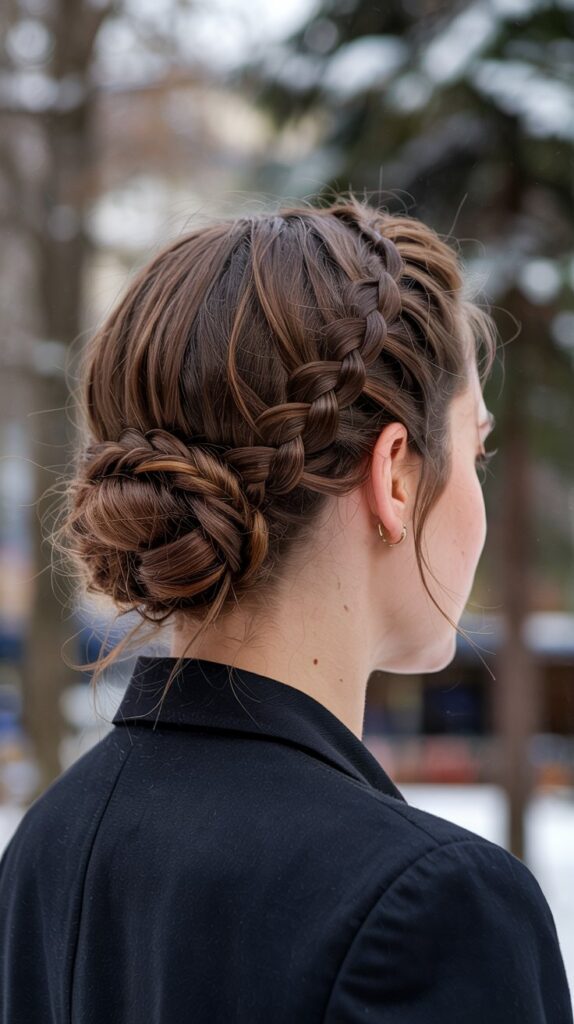
The wrapped braid bun conceals a braid’s length by coiling it around itself, creating a textured, dimensional bun perfect for winter’s polished occasions.
- After completing a braid of choice, wrapping it around its base in a spiral and securing with pins creates a bun with visible braided texture throughout its surface.
- This technique provides more grip and structure than buns made from unbraided hair, helping them maintain shape throughout long winter days and evening events.
- The textured appearance adds visual interest that prevents simple buns from looking too basic or unfinished, elevating everyday styling to something more intentional.
- Different braid types create different textural effects in the final bun—three-strand produces uniform segments, fishtail creates herringbone patterns, rope creates spiral ridges.
- Positioning the wrapped bun at varying heights from low nape to high crown changes the overall look’s formality and appropriateness for different winter occasions.
30. Accent Braids with Loose Hair

Small accent braids woven throughout loose hair create subtle detail perfect for those wanting winter braid styling without fully committing to structured braided looks.
- Creating 3-5 small, thin braids at random positions throughout loose hair adds textured interest while maintaining the flowing, unstructured aesthetic of wearing hair completely down.
- This approach works excellently for casual winter settings including weekend activities and relaxed holiday gatherings where elaborate styling would feel inappropriate.
- The small braids help control problematic sections to static and flyaways without requiring full hair commitment, making them ideal for winter’s unpredictable hair behavior caused by dry air.
- Varying braid types within one style—mixing micro three-strand braids with thin rope braids and small fishtails—creates textural variety that appears artfully intentional rather than haphazard.
- Adding tiny clips, beads, or wrapping thread around individual accent braids incorporates seasonal colors and festive elements without overwhelming the overall natural appearance.
31. Knotted Braid
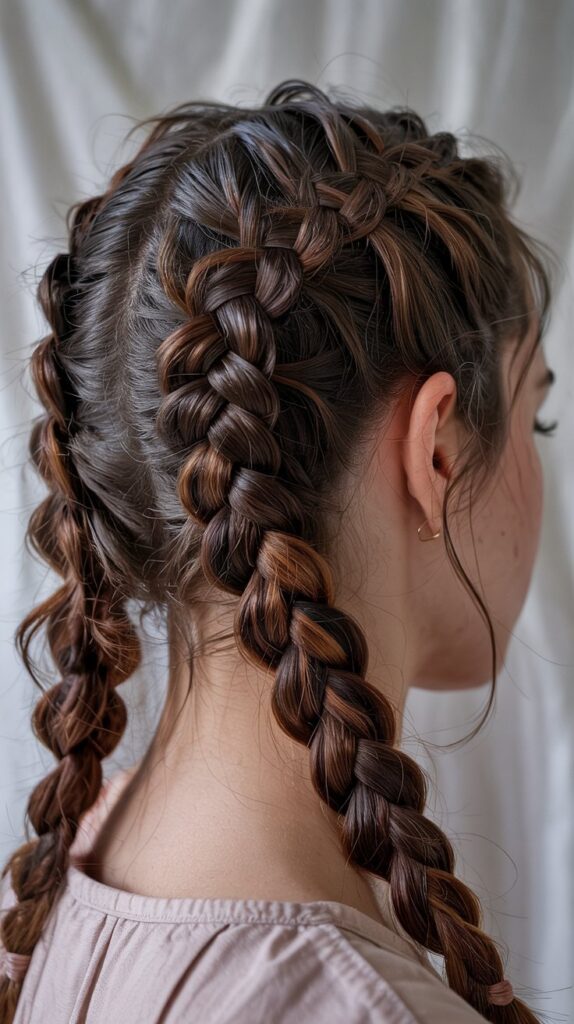
The knotted braid replaces traditional weaving with a series of small knots, creating unique texture that distinguishes winter styling from standard braiding techniques.
- Dividing hair into two sections and tying repeated small knots down the length creates a bumpy, segmented appearance distinctly different from woven braid patterns.
- This alternative technique appeals to those who find traditional braiding coordination challenging, as simple knot-tying requires less complex hand movements and spatial awareness.
- The knotted texture creates exceptional grip and hold, making this style particularly long-lasting for winter activities where hair needs to stay secured for extended periods.
- Winter’s textured, layered clothing aesthetic complements the bumpy, dimensional nature of knotted braids without the smooth elegance clashing with casual winter fabrics.
- Loosening knots slightly after completing the full length creates fuller, more relaxed appearance appropriate for casual winter settings while maintaining structural security.
32. Twisted Crown Braid

The twisted crown braid creates a soft, romantic halo effect using twisting rather than traditional braiding, perfect for winter’s dreamy, ethereal styling moments.
- Two twisted sections starting from each side wrap around the head’s crown and secure, creating a softer, less structured alternative to traditional Dutch or French crown braids.
- The twisting technique generally takes less time than intricate braiding while delivering similar face-framing and hair-controlling benefits essential for winter styling.
- This style pairs beautifully with winter’s flowing, romantic fashion including maxi dresses, soft cardigans, and delicate jewelry without the severity of tighter braided crowns.
- Adding small seasonal elements like winter berries, pearl pins, or delicate gold leaves throughout the twisted crown creates holiday-ready styling within minutes.
- The softer nature suits those with naturally wavy or curly hair where the twist complements existing texture rather than fighting against it with overly structured braiding.
33. Braided Pigtails (Double Side Braids)
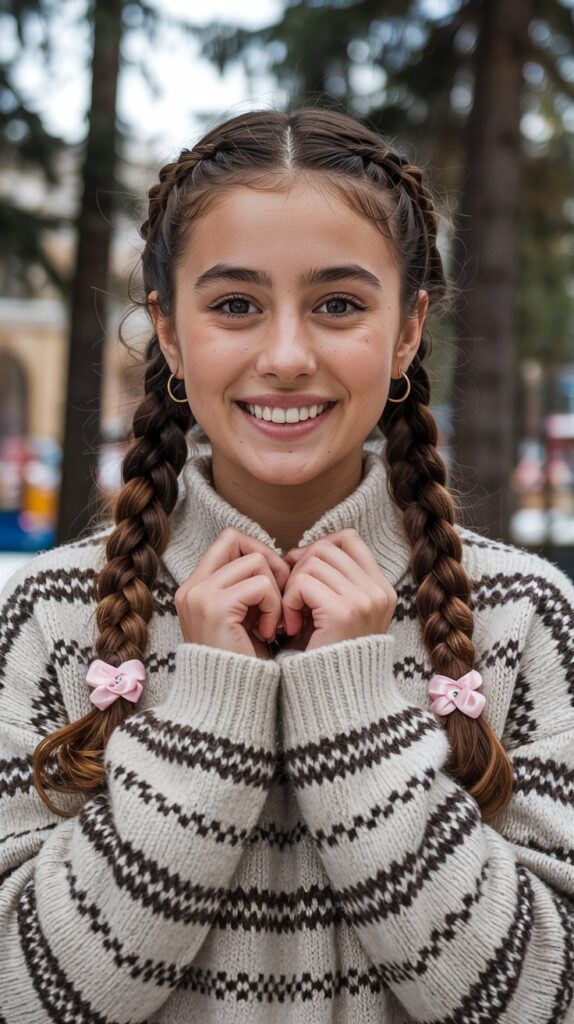
Braided pigtails deliver playful charm while providing maximum hair protection, making them perfect for winter’s active pursuits and casual styling moments.
- Two braids positioned symmetrically on either side of the head create youthful, energetic styling that works for all ages when executed with appropriate tightness and positioning.
- This classic style offers exceptional practicality for winter outdoor activities including sledding, building snowmen, and winter hiking where complete hair control is essential.
- Positioning the part and braid placement higher or lower on the head adjusts the overall look’s maturity—lower pigtails appear more sophisticated than high, youthful placements.
- Winter sports enthusiasts appreciate braided pigtails for fitting comfortably under helmets and staying completely secured during vigorous physical activity.
- Adding seasonal ribbons, colorful elastics, or wrapping decorative wire through the braids transforms basic pigtails into festive holiday styling appropriate for winter celebrations.
Essential Products for Winter Braiding Success
Winter conditions require specific products that address cold-weather hair challenges while facilitating beautiful braiding results.
- Hydrating leave-in conditioners combat winter’s moisture-stripping effects, ensuring hair remains pliable enough for braiding without breaking or feeling brittle during manipulation.
- Texturizing sprays and dry shampoos provide the grip necessary for braids to hold securely, particularly important when indoor heating creates slippery, static-prone hair conditions.
- Anti-frizz serums applied after completing braids smooth flyaways and add shine without weighing down the style or making hair appear greasy under winter lighting.
- Strong-hold hairsprays formulated for humidity resistance maintain braid structure when transitioning between cold outdoor air and warm indoor environments throughout winter days.
- Silk or satin scrunchies and hair elastics prevent the breakage and denting common with rubber bands, protecting hair health while securing winter braids gently yet effectively.
- Overnight protective bonnets or silk pillowcases extend braid longevity by reducing friction during sleep, allowing styles to last multiple days without daily restyling requirements.
Accessorizing Winter Braids
Strategic accessories transform basic braids into holiday-ready winter styling that celebrates the season’s festive spirit.
- Metallic wire or tinsel woven through braids catches winter light beautifully, creating sparkle appropriate for holiday parties and special celebrations without appearing overly costume-like.
- Pearl pins and decorative bobby pins add elegant detail to formal winter braids, elevating simple styles for weddings, corporate events, and refined holiday gatherings.
- Velvet ribbons in deep jewel tones complement winter’s rich color palette while adding luxurious texture that pairs beautifully with seasonal fashion choices.
- Fresh or faux winter greenery including small eucalyptus sprigs, pine needles, or winter berries creates organic, natural styling perfect for rustic winter celebrations.
- Statement hair clips and barrettes positioned at braid bases or throughout lengths add personality while providing extra security for thick, heavy winter hair.
- Seasonal headbands worn over braided crowns layer accessories for maximum impact while keeping ears warm during outdoor winter activities and events.
Conclusion
Winter styling reaches its full potential when you embrace the protective beauty and versatile elegance that braids naturally provide throughout the coldest months of the year.
33 Easy Winter Hair Braids You’ll Love has equipped you with an extensive collection of braiding techniques spanning simple classics perfect for beginners to intricate artistic styles that challenge advanced stylists, ensuring options for every skill level and occasion throughout the season.
These carefully selected braid styles address winter’s unique hair challenges—combating static, managing moisture loss, protecting against harsh winds, and maintaining polish despite temperature fluctuations—
while delivering the stunning visual impact that makes cold-weather styling memorable and Instagram-worthy.
From casual weekend braided pigtails to sophisticated crown braids worthy of winter weddings, from athletic boxer braids that withstand ski slopes to romantic waterfall braids perfect for holiday gatherings, you now possess the knowledge to transform your winter hair routine into something truly special.
The practical tips for winter hair care, product recommendations tailored to cold-weather conditions, and creative accessorizing suggestions ensure your braids not only look beautiful but also promote hair health during winter’s most challenging environmental conditions.
As you experiment with these 33 distinct braiding styles throughout the winter season, you’ll discover personal favorites that match your lifestyle, skill level, and aesthetic preferences while building confidence in your braiding abilities through consistent practice.
Remember that winter’s cozy aesthetic naturally complements the textured, dimensional beauty of braided hairstyles, making this the perfect season to expand your styling repertoire and embrace new techniques that will serve you for many winters to come.
